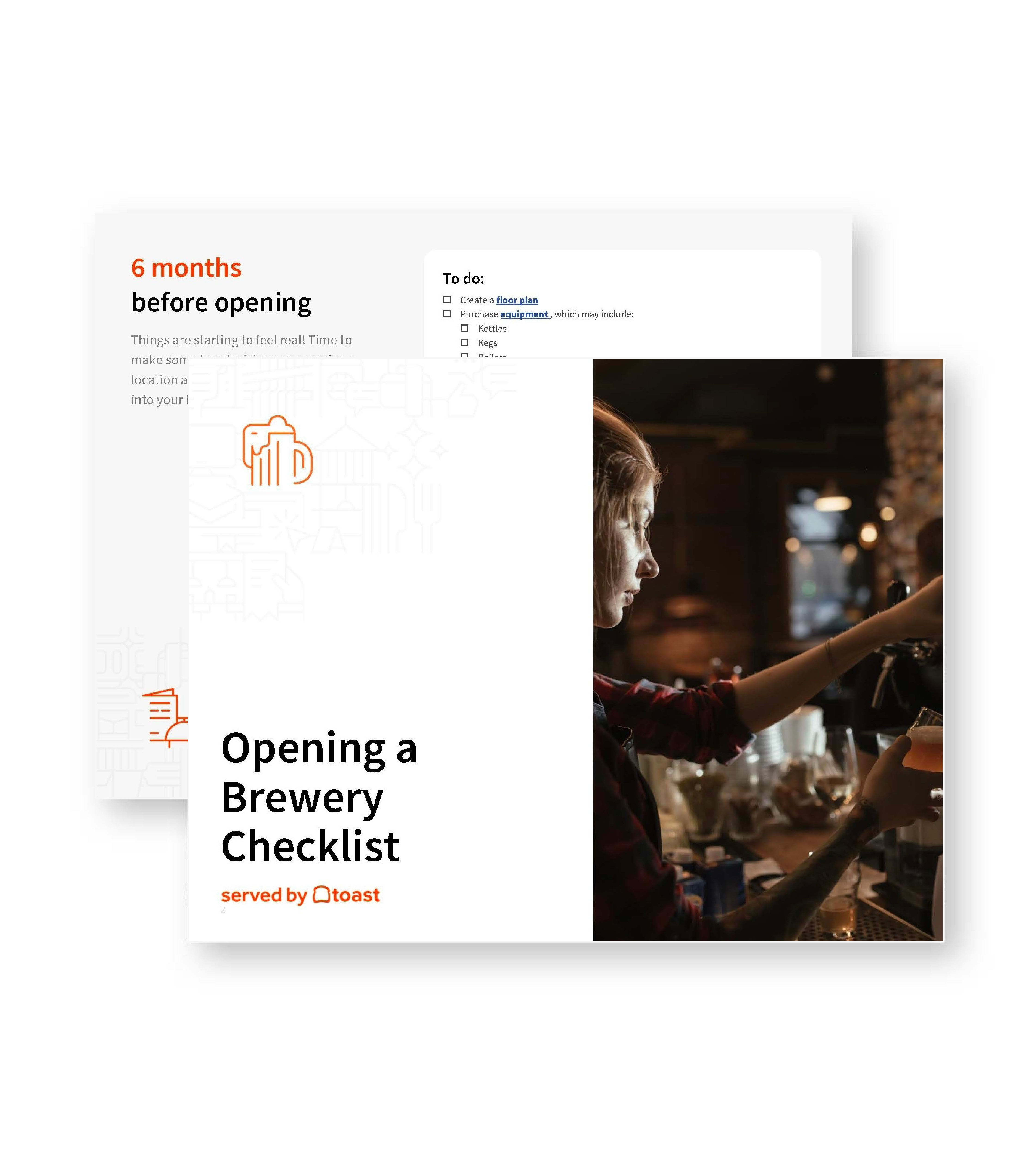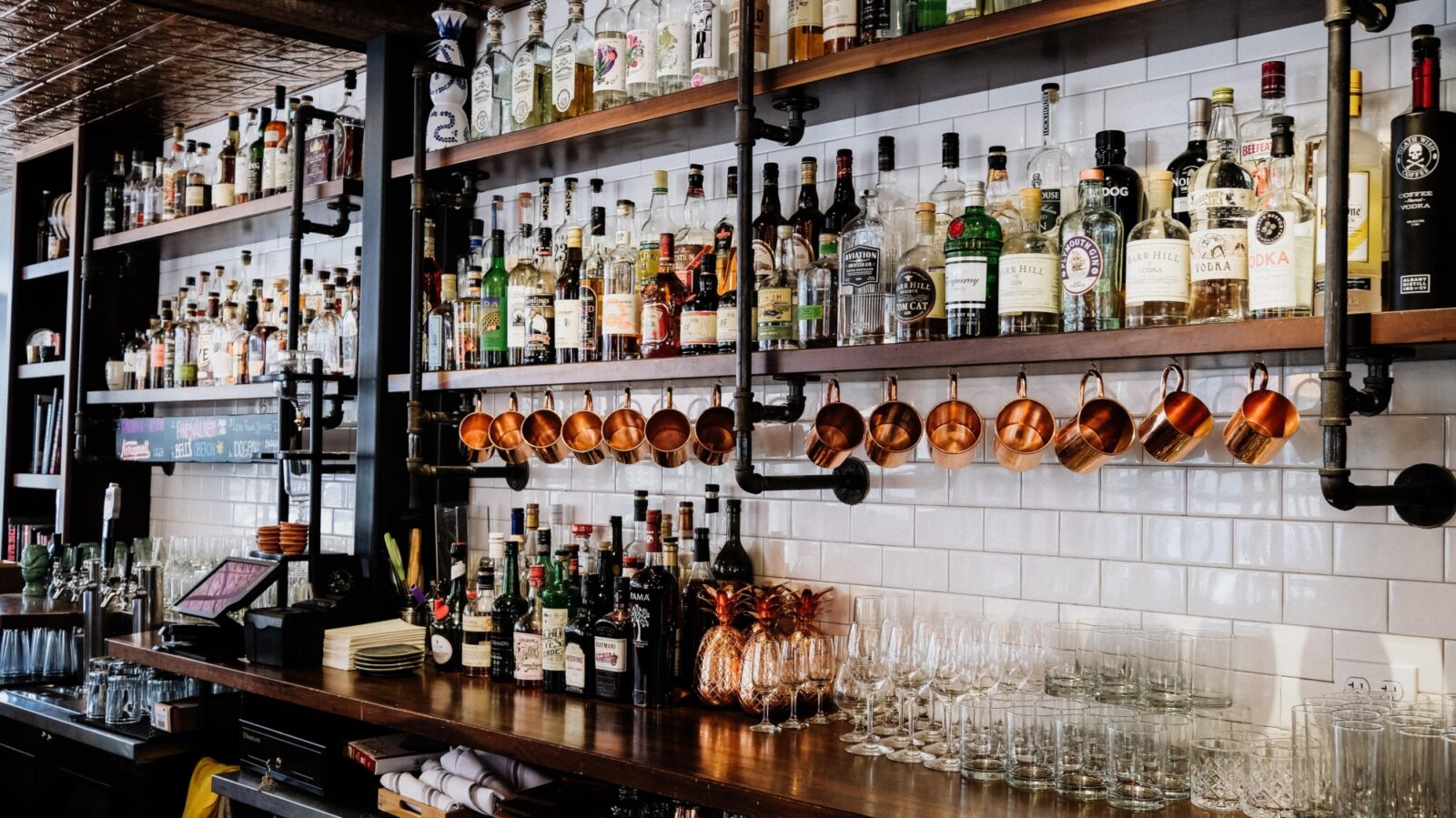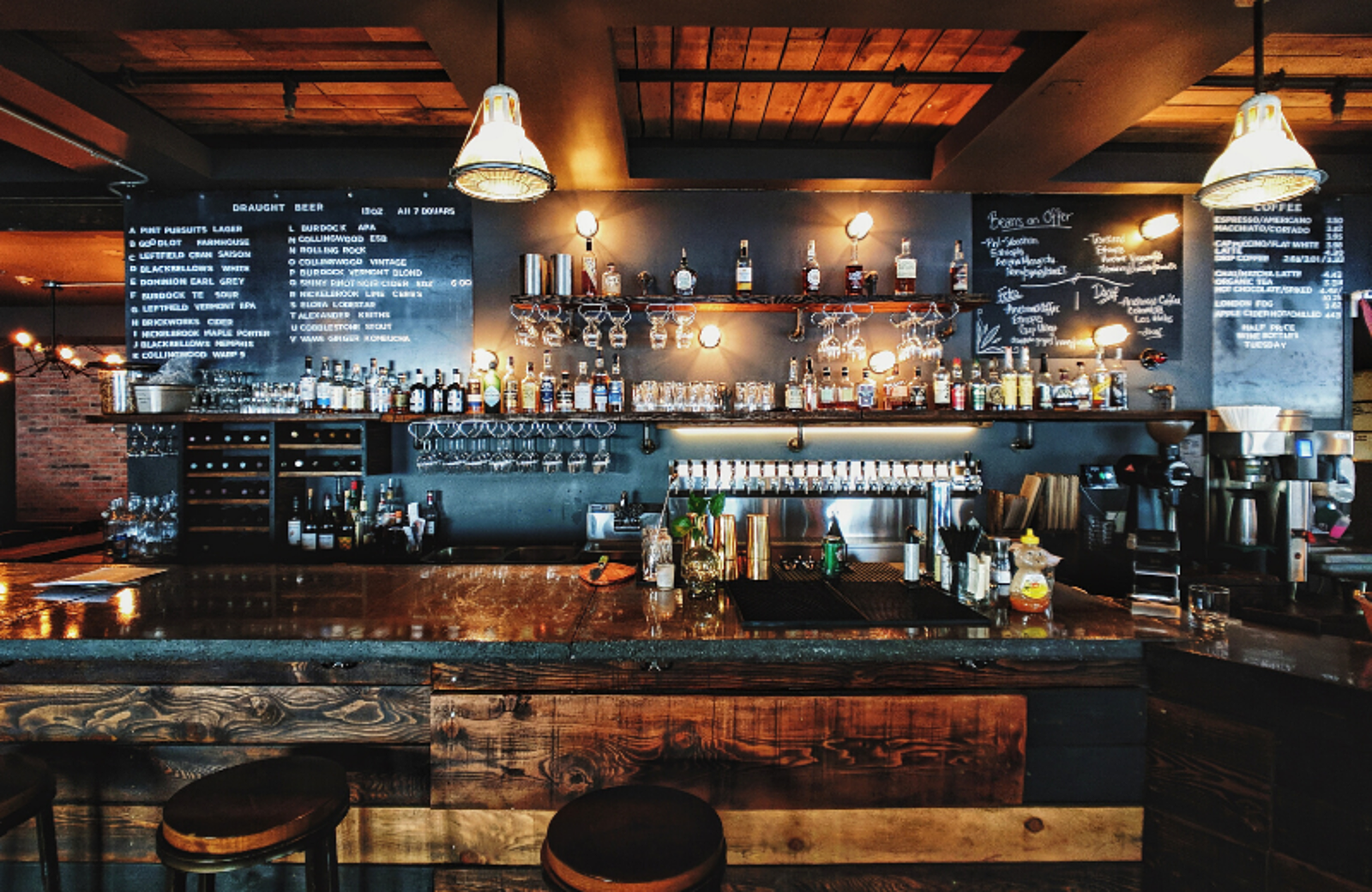
How to Open a Brewery: Starting a Brewery Business Steps
A brewery can be a dream come true for any beer-loving entrepreneur. Here's what it takes to open one.

Caroline PriceAuthor


Opening a Brewery Checklist
So many things go into opening a brewery. With this free PDF checklist, you'll set your new business up for success.
Get free downloadWhat Do You Need to Start a Brewery Business? (Checklist)
Opening a restaurant is exciting, and a brewery can be a dream come true for any beer-loving entrepreneur. But opening a brewery is also time-consuming and expensive, so it’s important to follow the correct steps to get your business off on the right foot.
Here are a few things to consider as you think about opening a brewery.
How to Start a Brewery
Talk to people in the brewing industry in your city and get a sense for what their process was like. Then, if you’re still on board to start your own brewery, here are some steps you can take to get started.
1. Choose a brewery format
First: what is a brewery? Also called a brewing company, a brewery is a business that produces and sells beer. Here are a few specific brewery concepts to consider.
What is a Craft Brewery?
A craft brewery is a small and independent brewery that, according to the Brewer’s Association, pride themselves on maintaining local brewing traditions while cultivating unique flavor profiles.
What is a Microbrewery?
A microbrewery operates just like a typical brewery, but with a smaller volume. A microbrewery produces fewer than 15,000 barrels, or 460,000 gallons annually.
What is a Brewpub?
A brewery that sells more than 25% of its beer directly to consumers on-site is called a brewpub. Brewpubs also have a restaurant component to their business and provide a more robust on-site customer experience than traditional breweries.
2. Create a brewery business plan
Once you have your concept secured, the next step to starting any business is spinning up a business plan. A restaurant business plan is a blueprint for your entire project and it explains in detail how you will finance, operate, market, staff, and run your business once you’re open.
Here, you’ll talk about your company overview, your operations (who are your suppliers? What is your staffing and service model?), and even more detail that will help you get everything going.
Get to work on your brewery business plan with this template so you don't have to start from scratch.
Brewery Business Plan Template
Use this free template to easily create a great business plan that organizes your vision and helps you start, grow, or raise funding for your brewery.

3. Decide on a brewery location
If possible, taking over an old brewery is easier, for obvious reasons. But if you're starting from scratch, you'll need a very large space that can accommodate your taproom with its massive brewing tanks and the rest of your brewing equipment.
Here are a few things to consider before choosing the right location for your brewery:
- Your Style – Are you rustic? Elegant? Casual? This can determine the type of customers you’re likely to appeal to.
- Target Market – Different areas of your city appeal to different people. If you’re looking to appeal to college students, opening near a university makes sense. If you’re looking to attract families, set up shop in a more residential part of town.
- Accessibility and Parking – If you’re attracting tourists, parking is less of an issue since they’re likely to call a cab or use Lyft or Uber. However, tourists are less likely to be repeat customers. Keep this in mind when choosing your location.
- Zoning Restrictions – Can you open a brewery here?
- Rent and Utilities Costs – Will you be able to make this up in sales with the type of customers you’re going to draw in?
Here's some more info on finding a brewery location.
4. Look into brewery legal requirements, licenses, and permits
Any restaurant that serves (let alone produces) alcoholic beverages is going to require specific alcohol licenses, along with others to operate your business. Make sure to Google your state-level requirements. Here are just some of the licenses you'll need:
If you’re selling merchandise, you also might need a retail license, and a music license or live entertainment license if you’re showcasing local bands. Not acquiring the proper license is a silly mistake that can cause your bar to close down, so work with a professional to ensure everything is good to go.
5. Collect the tax, DBA, and EIN information for your brewery business
In addition to having various restaurant licensing and permit requirements, states also have differing tax and employer requirements that are required for opening a brewery. And similarly, it’s also a good idea to start this process early to avoid missing deadlines and working with a professional to help you through it. Understanding restaurant tax requirements is key to avoiding fees and fines as a new business.
Collect the necessary tax paperwork through either an in-house or third party tax professional. Then, if applicable, file for your DBA (Doing Business As) — also known as your unique trade name.
Finally, if you plan to hire employees at any point, you'll need to apply for an EIN (Employer Identification Number) that will allow you to file income and payroll tax returns.
These are just a few of the important regulatory steps that you’ll need to follow, so just like with licenses and permits, get googling and find out exactly what you need to do in your state and county, and consult with a professional.
6. Design your brewery branding, marketing, promotion, and advertising strategy
Set up your grand opening for success and get customers in the door with great marketing. The best place to start is by creating your restaurant marketing plan - where you can set goals, implement best practices and tips, and plan out your marketing calendar and budget for that critical first year.
Developing your marketing strategy begins by defining exactly what it is you are marketing. What is the unique appeal of your brewery? What does your atmosphere or aesthetic have to offer customers? The specific offering of your brewery and its intended audience will drive your branding.
When determining your approach to marketing and advertising, ask yourself questions such as:
- Who is your target brewery customer?
- What platforms will you use for online marketing?
- Which social platforms will you prioritize?
- Will you use organic marketing practices or pay for advertising?
- Will influencer marketing play a role in your strategy?
- Where does your target audience spend their time? How can you advertise in these spaces?
When you launch your new shop, developing a strong restaurant social media marketing strategy can help to showcase your beer in a visual and shareable format. Social media helps put breweries on the map and attract new customers.
You can also use Toast’s Restaurant Marketing Plan template to build out your plan for how you’ll keep the guests coming through your door — and coming back for more.
And, get your brewery off to a great start with a grand opening. Here are some ideas to get you started, and generate early buzz for your brewery.
Brewery Equipment Checklist
Opening or upgrading a brewery? Don't miss any essential equipment! Download our free, comprehensive Brewery Equipment Checklist.

7. Figure out your brewery finances, sales forecasts and operating expenses
At this stage, it’s time to revisit your restaurant business plan and look at your initial financial projections for your brewery so you can plan out day-to-day operating expenses. With a more thorough understanding of your operating and marketing costs, you can more accurately predict the future earnings.
How much does it cost to start a brewery?
How much does it cost to open a brewery? While there isn’t any set amount, the general cost of opening a brewery is between $500,000 to $1,500,000. In addition to the typical expenses associated with opening a restaurant, the specific equipment needed to start a brewery is expensive, and costs can add up quickly.
NerdWallet laid out some of the essential equipment needed, including “kettles, kegs, boilers, bottling and canning lines, conveyors, cooling systems, storage tanks, fermentation tanks, filters and beer-labeling machines, piping and tubing, refrigeration equipment, cleaning equipment, waste treatment systems and tap handles.” This equipment is expensive, but most are a one-time cost.
For more information on the typical costs of opening a restaurant, check out this post.
How much does it cost to run a brewery?
When factoring in the costs of running a brewery business, think about equipment, staff, marketing, building, tech, and food. The typical operational costs for running a restaurant include fees such as:
- Utilities: $1,000-$1,200/month
- Equipment and appliances: $20,000-$400,000
- Licenses, permits, deposits: $2,500-$200,000
- Technology, including a POS system: Varies
- Food costs: $5,000-$25,000
- Restaurant labor costs: 30-35% of total revenue
To make sure you keep your personal and brewery expenses separate, open your business bank account — this is mandatory in some states for tax purposes. Either way, this step is also where you will get your business credit card. Do your research and work with a great accountant through this whole process to make sure it's done right.
8. Secure brewery funding and loans
Most people don’t have $500,000 in the bank to start a new business. The good news is that restaurant financing is available, and there are numerous options to consider. Trying to figure out how to open a brewery with no money? The various means of funding you may utilize to start your brewery include:
- A business line of credit
- SBA Microloans for small-businesses
- Brick and mortar bank loan
- Startup business grants
- Equipment financing for the brewery kitchen
- Merchant cash advance
To learn more, read this post about all the different ways you can get restaurant financing.
Once you've got your financing, you can start buying equipment and setting up your space with the basics that you'll need to get started.
9. Build your brewery menu
As mentioned above, the equipment needed to start a brewery is well above and beyond the standard restaurant equipment list. This brewer's website has a big list of all the categories of equipment you'll need for a commercial brewing operation.
You'll also need food inventory to start bringing your dream menu to life, plus large quantities of your beer ingredients like hops, malt, and other specialty items that make your brew shine.
Start building your brewery menu based on your individual concept. Are you offering a full food menu? A small-bites menu? Only beer? This is the time to figure this out.
Start by simply writing down all of your ideas before organizing them into groups based on ingredients and supplies needed. Take a peek at what your competition offers, and see where you can fill a gap in the market or jump on industry trends.
Brewery Menu Templates
Use these brewery menu templates as a starting point for your menu design or to give your menu a refresh.

10. Find your brewery inventory supplier
Now that you've determined your menu items — in addition to the ingredients and materials you’ll need to make them — you can begin purchasing your inventory. Of course, first you’ll need to decide where you’ll be purchasing your supplies from.
There are many food industry wholesale platforms that you can use for your inventory. Additionally, depending on your location, you’ll be able to find a collection of local retailers from which to obtain your products.
Wherever you decide to get your inventory from, it’s always a good idea to take your time reading reviews and chatting with your peers about potential suppliers. Overcoming supplier delays and miscommunications can be a real hassle for breweries, especially when they are just getting started establishing themselves. To avoid inventory hassles, partner with a supplier who you trust and respect.
Remember to continuously track your inventory shipments using restaurant inventory management software and create a backup plan to account for any delays.
11. Invest in a brewery point of sale system
Another important decision you’ll have to make regarding the operations of your shop is choosing your point of sale system. The best POS systems for emerging organizations are user-friendly and capable of scaling alongside a fast growing brewery — and they make the payment process seamless for guests and for staff.
Toast’s POS can do all that and more, while providing you with the reporting and analytics that will help you keep track of your business’s performance and health.
Restaurant POS software benefits breweries with features like:
- Simple interface: For quick order turnaround, large buttons and an easy user interface can speed up long lines on busy weekends.
- Handheld devices and Order & Pay at the Table: On-the-go brewery operations need handheld POS devices to take customer payments and sell products from anywhere, and Order & Pay at the Table technology lets guests keep the orders coming throughout their whole visit, without waiting in line or for a server.
For more information, here’s everything you need to know about Toast’s POS System.

12. Craft your brewery design and atmosphere
With a thorough restaurant business plan and vision, you’ll now need to design a restaurant floor plan and layout that will align with your brewery business goals. As an owner, your passion for the craft and your story will influence the design and atmosphere of your brewery.
The goal is to make your brewery into a place where customers can feel comfortable and welcome, a warm space that offers tasty delights and an inviting atmosphere.
What should your brewery floor plan include?
When designing your restaurant layout, keep these elements in mind:
- The kitchen
- Brewing equipment like kettles, kegs, boilers, cooling systems, storage tanks, fermentation tanks, and refrigeration equipment
- Tables and chairs
- The counter, if you’re a counter service brewery
- Restrooms
- Windows
- Doors
- Exits
13. Hire your brewery team and management
A great staff is the backbone of a successful restaurant. Specifically for a brewpub, you’re looking for two sets of staff: those who will produce the beer, and those who will be serving beer and food to customers. And if you'll be making food in-house (as opposed to partnering with another food business like a food truck), you'll also need back-of-house kitchen staff.
When hiring for a brewery or other restaurant, you can use restaurant industry job sites like Culinary Agents, Jobs On The Menu, or Poached.
Open your doors
And you’re off! Though the process of opening a new brewery can be daunting, taking it one step at a time and doing your research will make the process easier.
Related Brewery Resources
Brewery Business Plan Template
Use this free template to easily create a great business plan that organizes your vision and helps you start, grow, or raise funding for your brewery.

Is this article helpful?
DISCLAIMER: This information is provided for general informational purposes only, and publication does not constitute an endorsement. Toast does not warrant the accuracy or completeness of any information, text, graphics, links, or other items contained within this content. Toast does not guarantee you will achieve any specific results if you follow any advice herein. It may be advisable for you to consult with a professional such as a lawyer, accountant, or business advisor for advice specific to your situation.
Read More
Subscribe to On the Line
Sign up to get industry intel, advice, tools, and honest takes from real people tackling their restaurants’ greatest challenges.



